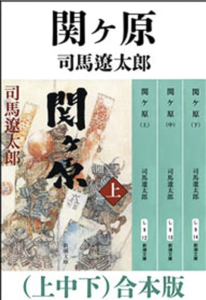Life Tips & Miscellaneous Travel and History Sports and Arts Books, TV, Movies and Music Zen and Life Tips Navigation of this blog
Ryotaro Shiba, Shotaro Ikenami and historical novels
Both Ryotaro Shiba and Shotaro Ikenami wrote novels in the genre of historical fiction, and both were born in 1923. The novels of Ryotaro Shiba are the most popular.
Ryotaro Shiba’s novels have been made into movies in succession: “Sekigahara” (2017, amazon prime), “Burning Sword” (2021, amazon prime), and “The Last Samurai” (2022, amazon prime).



In a survey conducted to commemorate the 100th anniversary of his birth, “Saka no Ue no Kumo” (Clouds over the Hill), mentioned in “Kaido wo Yuku – Minami Iyo, Nishi Tosa no Michi: Saka no Ue no Kumo to Nangoku no Date Family” (Clouds over the Hill and the Date Family in Nangoku) came in first place, “Ryoma ga Yuku” (Ryoma Goes) came in second place, “Burn Your Sword” came in third, “Kaido wo Yuku” (On the Road: Ryotaro Shiba and Japanese Roads) came in fourth place, and “Toge” (The Pass) came in fifth. The fifth place went to “Touge” (The Mountain Pass).
Ryotaro Shiba was born in Osaka and won the Naoki Prize for “Owl’s Castle” when he was a newspaper reporter for the Sankei Shimbun newspaper. He has a style that combines his unique view of history, known as “Shiba’s historical perspective,” with a deep religious outlook due to his membership in a religious press club in Kyoto when he was a reporter. He became one of the most popular writers in Japan.

In contrast, Shotaro Ikenami is famous for his three major series, “Onihei Hankacho,” “Kenkaku Shobai,” and “Umeyasu Fujieda, the Trap Man.



They have been dramatized many times. (Onihei Hankacho amazon prime, Kenkaku Shobai amazon prime, Kikkoman Fujieda Umeyasu amazon prime)
Shotaro Ikenami was born in Asakusa, Tokyo, and worked in Tokyo’s Shimotani Ward (now Taito Ward) while writing many plays and gradually shifting to novels, winning the Naoki Prize for “Deran”. Unlike Ryotaro Shiba, his style of writing did not look down on history, but rather depicted everyday life from a level-headed perspective. As he said, “People sleep, eat, and have children, and when things go wrong, suspense arises and incidents occur,” he created his works with the stance that people’s behavior, or the accumulation of daily life, shapes history.

Historical novels” written by Ryotaro Shiba and Shotaro Ikenami are novels based on past eras, people, and events, and are often set in the Meiji period or before. Historical novels are similar in genre to historical novels, but the main characters in historical novels are actual historical figures, and the main part of the story is based almost entirely on historical facts. The author is moved by the life and thought of the main character, and the actions and words of the main character contain the motifs that the author wishes to appeal to the reader.
In contrast, historical novels either feature fictional characters or, even if they do use real characters, they develop in a way that differs from historical facts, and they emphasize entertainment rather than historical facts or the author’s appeal. In this sense, Ryotaro Shiba is a writer of historical novels, while Shotaro Ikenami is a writer of historical novels.
The genre of historical novels is not that old; for example, “Daibosatsu Touge” by Nakazato Kaizan, which began to be serialized in 1913, is said to be one of them.

Another master of historical fiction is said to be Eiji Yoshikawa, who wrote “Musashi Miyamoto.

These books can be read inexpensively because their copyrights have now expired. For example, “Daibosatsu Touge” features a nihilist swordsman named Teku Ryunosuke, reflecting the darker times of the Taisho era before the Showa War, and “Miyamoto Musashi” is said to have become a bastion of Japanese ninja obedience before the war. These novels are composed by copying the background of their respective eras, and although they are historical novels depicting the “past,” they can actually be said to reflect the “present” era.
The 166th Naoki Prize was announced in 2022, and the news was that the two prize-winning novels, “Kokurojo” (Yonezawa Honobu) and “Saou no tate” (Imamura Shogo), are both historical novels. These writers were originally “full-fledged mystery writers” as well. In recent years, writers who have been writing in other fields have entered the historical novel genre, such as Ryosuke Kakine’s “Muromachi Muyori,” Keiki Kadoi’s “Ieyasu, Edo wo Kenzate” and Yuichi Shimpo’s “Shin Keian Taiheiki.





Combined with fiction from a variety of other areas, “historical fiction” is still recognized as one of the most popular genres today.


コメント